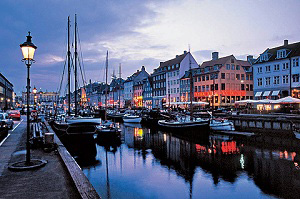
Copenhagen Guide
Copenhagen offers a wide variety of attractions for all ages. The best place to start your citybreak Copenhagen is right in the middle of the city centre. Here you will find big tourist attractions such as the Tivoli entertainment park in front of the central station, the Town Hall Square, the main shopping streets and some interesting museums like the Ny Carlsberg Glyptotek and the National Museum.
A little bit more northeast of the city centre you can experience a royal atmosphere in the Frederiksstaden quarter where the amazing Amalienborg, the Royal Palace of Denmark, is located. Also have a glance at the aristocratic houses and exclusive boutiques in this area.
In Copenhagen you will also find some pleasant parks like the gardens surrounding the Rosenborg Palace, the Botanic Garden that belongs to the University of Copenhagen. Or what about a visit to the beautiful Assistens Cemetery with the graves of some famous Danish people like the writer Hans Christian Andersen and the philosopher Søren Kierkegaard?
Also don’t forget to explore Copenhagen from the water. At Nyhavn you can get on a special tour boat for a sightseeing tour through the Copenhagen harbor, including a visit to the Little Mermaid. Other places in Copenhagen of special tourist interest are the multicultural district Nørrebro, Freetown Christiania and the remarkably colorful houses in the Latiner quarter.
History Copenhagen
For centuries, people have been living at the location where we nowadays find the city of Copenhagen. The main sources of income of the early inhabitants of Copenhagen were fishery and agriculture. Copenhagen suffered a lot from attacks of the Wends. It was Absalon, the bishop of Roskilde, who commissioned the construction of a fortress at the location where we nowadays find the Christiansborg to protect the city. Therefore he is officially declared the founder of Copenhagen in 1167. Copenhagen was situated on a strategic location and became a major port.
Thanks to the port activities Copenhagen was a fast-growing city and became the capital of Denmark around 1444. More and more people came to Copenhagen to work in the fishing sector or in the construction of galleons. Under the control of King Christian IV Copenhagen turned into the most important trading centre of northern Europe during the 17th century and kept on developing during the 18th century. Copenhagen’s long history as a port explains the name of the city. The original name, from which the current name of the city is derived, was ‘Køpmannæhafn’, which literally means ‘merchants’ harbor’.
Copenhagen was brutally attacked by the English in 1807. A big part of the city was destroyed. Fortunately in the second half of the 19th century Copenhagen, like most European cities, started to flourish again due to the Industrial Revolution.
Today Denmark is still a monarchy. The contemporary monarch of Denmark is Margrethe II. She reigns over Denmark since 1972.
